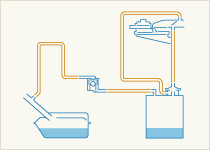
Evaporative Emission Control
Evaporation of gasoline from the fuel system is potentially a much greater source of airborne hydrocarbons than tailpipe emissions, so modern gasoline vehicles are equipped with fuel systems which are fully closed and designed to maintain a stable fuel tank pressure without allowing vapour to escape to the atmosphere. A canister of activated charcoal absorbs excess fuel vapour which builds up in the system, especially in hot conditions, and holds it until engine operating conditions are suitable to accept a fuel-rich mixture. Then the vapours are purged into the engine intake manifold where they mix with incoming air and are burned in the engine. The canister is then cleared of fuel and ready for further use.
Example Vehicles

Honda FCX Hydrogen

Hyundai Tucson Hydrogen
Hydrogen
Hydrogen is often called the fuel of the future because it contains no Carbon (and therefore produces no CO2) and it can be made from water.
However there are considerable problems to be overcome:
- the amount of energy required to make it, by separating the Hydrogen and Oxygen in water,
- its highly explosive nature when mixed with oxygen
- its very low density (the lightest material in the universe!) and consequent low energy density
So it is likely to be some years before it becomes a serious contributor. Nevertheless, Auto manufacturers are already working hard on the technology to use Hydrogen in internal combustion engines, and in the longer term in fuel cells, which produce electricity directly from the fuel, without burning, making it more efficient and much cleaner than a combustion engine.
Example Vehicles

Dodge Ram Power Wagon LPG

Renault Kangoo LPG
